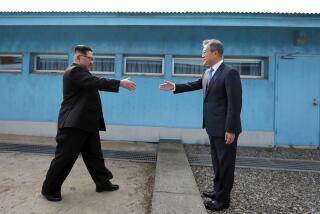Book Review : Korea: A Tale of the Dragon in Winter
Enter the Dragon: China’s Undeclared War Against the U.S. in Korea, 1950-51 by Russell Spurr (Newmarket Press: $22.95; 394 pages, illustrated)
A bitter, frustrating and finally futile struggle for all combatants, the Korean conflict was a watershed in America’s relationship with Asia. The success of Chinese arms during the savage winter of 1950-51 made it almost certain that the United States would intervene in Vietnam 15 years later, and that this intervention would fail.
The Chinese assault across the Yalu River defined “Communist aggression” for an entire generation of Americans. Dean Rusk, the secretary of state in the Kennedy and Johnson administrations, repeatedly invoked the danger of military expansionism by “one billion Chinese” to justify the American effort to contain the spread of communism in Vietnam.
But the image of Chairman Mao’s surging hordes meant something quite different to America’s generals. Korea had been their nightmare, and fears of a repeat of Chinese intervention ruled out an American invasion of North Vietnam, thus dooming the U.S. crusade in Indochina.
The first 18 months of the Korean conflict created this double fear of Chinese aggressiveness and martial prowess, and Russell Spurr has retold the story of these decisive days in a vigorously written dramatization of the battle on both sides of the conflict. The result is a thrilling narrative that holds the reader to the last page.
Courage and Toughness
For once, the Chinese and North Koreans are presented not as a faceless “yellow peril” but as men of extraordinary courage and toughness who suffered terribly even in victory.
They were also brilliantly led, and it is one of Spurr’s achievements to have created arresting portraits of the Chinese commanders--men such as Capt. Lao Kongcheng, Col. Wong Lichan and Gen. Peng Duhuai--to set beside the American pantheon of Ridgway, Almond, Smith and the savior of Pusan, Col. “Mike” Michaelis.
Spurr has aimed for balance, but “Enter the Dragon” is no revisionist whitewash of the other side in the name of fair play. The story opens with an early assessment of North Korean chances through the eyes of Chinese Col. Wong Lichan, the liaison officer to the North Korean army during the early stages of the fighting. Spurr draws on the battlefield experience of this pivotal Chinese figure to trace the military and diplomatic developments that led to Beijing’s involvement.
Spurr’s pictures are intensely personal: “Colonel Wong Lichan of the People’s Republic of China, groping about in the darkness, touched something soft and sticky. It was a body. What part of a body he couldn’t quite make out, but his fingers felt tacky with blood. Someone was groaning. The Chinese officer fumbled around in his combat jacket for an emergency field-dressing. He shook his head dazedly, wondering how you applied these bandages blind. The lights had been snuffed out, leaving the place as dark as a demon’s dungeon. The crash of the explosion had left him so deaf it took time to realize somebody was yelling. That somebody was the general.”
Reporter on the Front
He later switches to the desperate American defense of Pusan against a closing ring of North Korean armor during August, 1950. Here, Spurr introduces not only the exploits of Michaelis, the commander of the 27th Regiment (the Wolfhounds), but also Marguerite (Maggie) Higgins, the Pulitzer Prize-winning reporter.
Amid the powerful descriptions of actual fighting, Spurr always insists that we understand the wider picture. He sets out the background of the conflict and allows the reader to eavesdrop on Chinese military planning sessions in Beijing so that the strategic implications of battle are always fresh in the reader’s mind.
This three-step presentation (dramatic re-creations of the situation behind Chinese lines, followed by cuts to conditions in the American camp, and then a sketch of the big picture) is used as the author follows the course of battle through the original North Korean breakthrough, the American Inchon counterattack, the Chinese crossing of the Yalu, their “sharp swords” second and third offensives, then Ridgway’s deployment of his brilliant “meatgrinder” tactics that brought stalemate and the final showdown between Gen. Douglas MacArthur and President Harry Truman.
Fine, racy stuff, but is it history? Take the passage cited above, which is a mass of circumstantial detail. Spurr follows this with dialogue between his two Communist protagonists.
Is “Enter the Dragon” therefore “faction”; that is, a novel thinly disguised as journalistic reportage? Certainly Spurr’s imaginative re-creations expose him to the charge of being a novelist manque. Nevertheless he is a veteran British journalist who can boast decades of Asian experience, including many months in Korea covering the war.
Spurr’s description of Chinese wartime actions is based on interviews with veterans of Beijing’s military campaign. These are invaluable, but a professional historian of the Korean conflict would wish to be able to speak and read Russian and Japanese, to say nothing of Korean and Chinese, and it is not clear that the author is so equipped in any of the relevant languages.
Whether readers of Spurr’s enthralling tale will find his “history” satisfying will depend very much on what they are looking for. No one who demands the rigor of John Keegan’s “Face of Battle” should turn to Spurr for a history of the Korean War.
There is the occasional solecism. As an American, I was surprised to learn that Clement Attlee, not King George VI, was British head of state in 1950. Spurr’s description of Chiang Kai-shek as “Taiwanese head of state” is guaranteed to make politicians in both Beijing and Taipei perfectly furious. Gen. Chiang was Chinese. But for the 1950s nostalgist, the war veteran who was there, or indeed the young reader in search of an exciting story, this is the book, highly recommended for all but the serious historian.


